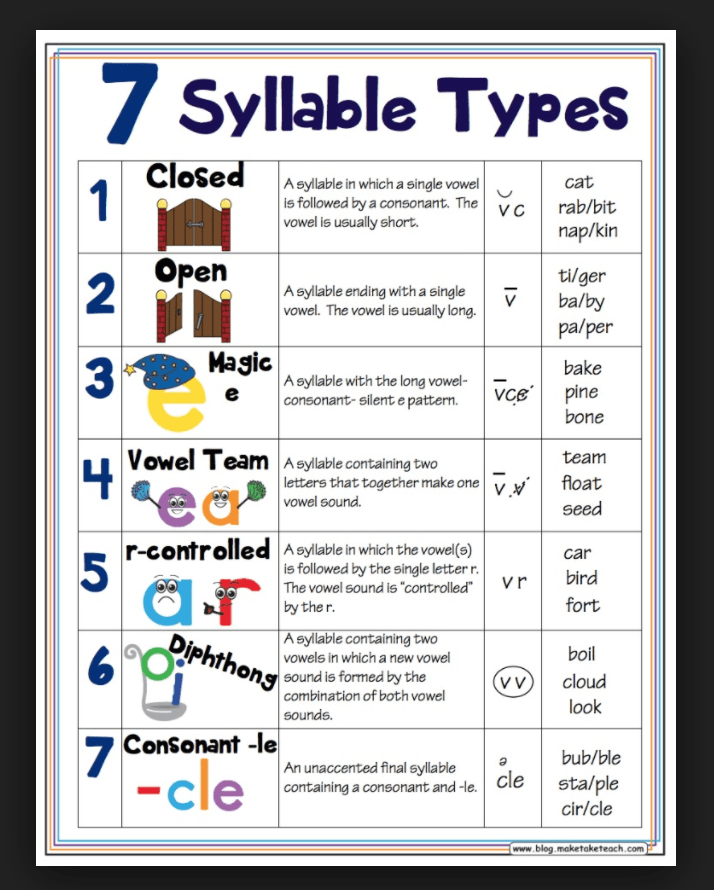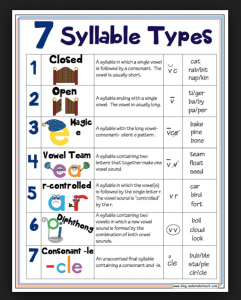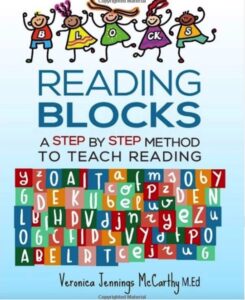We have to look at the definition of syllable first in order to learn how to divide a word into syllables. A syllable is defined as “a unit of pronunciation having one vowel sound, with or without surrounding consonants, forming the whole or a part of a word.” In other words, a syllable can be the whole word when the word is a one syllable word like: cat; hip; coat; black. Or, a syllable can be part of a word when the word has more than one syllable like: ba/by; trou/ble; hap/py; wil/low; cap/tion; mem/or/ies; Phil/ e/del/phi/a.

We can tell how many syllables a word has by listening for how many vowel sounds we hear in the word. Not how many vowels we see in the word, but how many vowels we hear in the word. Some vowels can be silent like silent e at the end of the word (gate) and some vowels team up with other vowels to form one sound like the vowel sound in “team”
The reason we need to learn how to divide words into syllables is because it will help us to sound out bigger words (multisyllabic words) that we don’t know.
There are Seven Types of Syllables
Closed Syllable (Block 2) – at, am, sat, will, did, its.
Open Syllable – (Block 4) – me, be, no, go, so, see, he, we, be, my, by.
Silent e Syllable – (Block 8) – slime, drive, plate, name, take, came, home, wide.
Vowel Team – (Block 13) – way, mean, boat, heat, need, road, green, deep.
R-Controlled Vowels – (Block 18) – hurt, ear, verb, short, more, year, clear, word.
Consonant + LE – (Block 23) – buckle, able, giggle, angle, uncle, puddle, gentle.
Vowel Diphthongs – (Block 27) – poison, boil, pound, shouted, haul, cause, because.
Each of these syllable types will be discussed in the corresponding block. Dividing words into separate syllables begins when the bulk of multisyllabic sight words are introduced in Block 8. Each reader can be given the summary sheet for syllable dividing when beginning the program. The reader can keep the summary sheet in his binder until the parent/teacher begins discussing how to divide bigger words into syllables. The reader can use the summary sheet to check off each type of syllable as it is introduced and practiced.
Syllable Summary
1) Closed Syllable – hit
2) Open Syllable – me
3) Silent e Syllable – plate
4) Vowel Team Syllable – team
5) R – Controlled Vowel – bird
6) Consonant + LE Syllable – bubble
7) Vowel Diphthong – boil
Dividing Reminders
-
- Divide prefix and suffix from root word – pre/de/ter/mine, ex/haust, walk/ing.
-
- Divide between two middle consonants – bal/loon, bub/ble, ap/ple, pat/tern.
- Divide between two middle consonants – bal/loon, bub/ble, ap/ple, pat/tern.
-
- Divide between compound words – cow/boy, pork/chop, mail/man, boy/scout.
- Divide between compound words – cow/boy, pork/chop, mail/man, boy/scout.
-
- Divide before or after an open syllable – o/pen, va/ca/tion, a/men, go/cart, hel/lo.
-
- Divide before the Consonant + LE pattern – work/a/ble, gen/tle/men, gig/gle, buckle (notice that when there is a –ckle ending, the ck will be split apart into two separate syllables).
- Divide before the Consonant + LE pattern – work/a/ble, gen/tle/men, gig/gle, buckle (notice that when there is a –ckle ending, the ck will be split apart into two separate syllables).
-
- Keep blends, digraphs, and consonant/digraphs together in the same syllable – sub/ stance, in/stu/ment.
- Keep blends, digraphs, and consonant/digraphs together in the same syllable – sub/ stance, in/stu/ment.
-
- Listen for number of vowel sounds, one vowel sound per syllable – gi/ant, near/ly, re/ ceiv/ing
-
- Keep vowel teams and vowel diphthongs together in the same syllable. Vowel diphthongs sound like two sounds but are only counted as one sound – boil, spoil, moun/tains, crouch, a/mount




